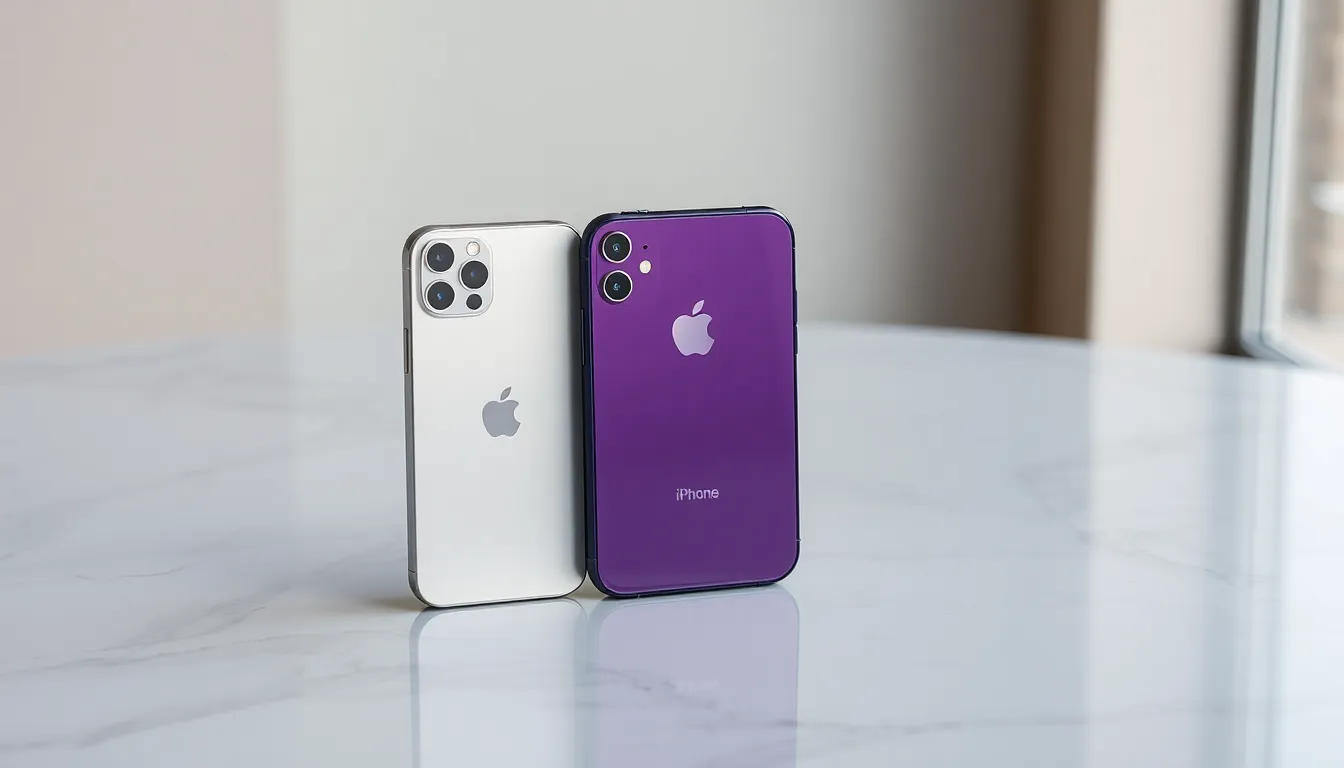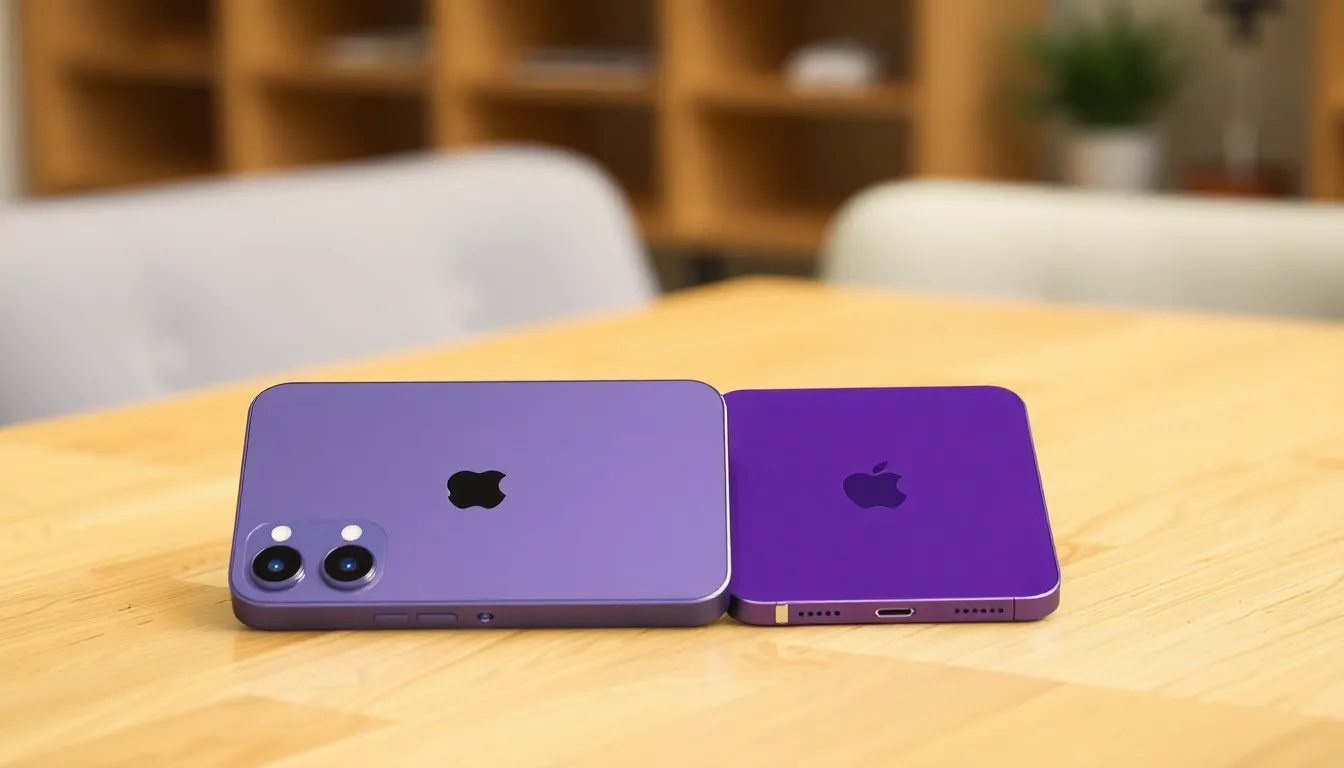When it comes to choosing between the iPhone Pro and Pro Max, it’s like picking between a perfectly brewed cup of coffee and an extra-large double shot. Both promise a delightful experience, but one just gives you a little more to savor. Apple’s Pro and Pro Max models cater to different needs, and understanding those differences can save you from buyer’s remorse—or worse, a case of “why did I choose this one?”
Table of Contents
ToggleOverview of iPhone Pro and Pro Max
The iPhone Pro and Pro Max models exemplify premium offerings in Apple’s smartphone lineup. Size differentiates the two, with the Pro Max sporting a larger 6.7-inch display compared to the 6.1-inch screen of the Pro. Enhanced battery life characterizes the Pro Max, providing around 20 hours of talk time versus the 17 hours available on the Pro.
Camera features also set the models apart. The Pro Max includes sensor-shift optical image stabilization, improving lowlight photography. In contrast, the standard Pro offers excellent camera quality but lacks this exclusive stabilization feature. Both models house impressive triple-camera systems, supporting features like Night mode and Deep Fusion, which deliver stunning photos.
Performance remains consistent across the models. Both utilize Apple’s A15 Bionic chip, ensuring seamless multitasking and efficiency. Storage options vary, with both models available in 128GB, 256GB, and 512GB configurations, while the Pro Max additionally offers a 1TB option.
Price points differ significantly. The Pro starts at a lower price, appealing to those who prioritize cost-efficiency without sacrificing features. On the other hand, the Pro Max comes at a premium, justifying its higher cost with added functionalities and larger display size.
Design similarities exist, showcasing sleek finishes in colors like Graphite, Gold, and Silver. While both models flaunt a durable design, the Pro Max is slightly heavier due to its larger dimensions.
Understanding these distinctions helps consumers make an informed choice. Selecting between the iPhone Pro and Pro Max hinges on individual preferences regarding size, camera capabilities, and budget constraints.
Design Differences

The iPhone Pro and Pro Max showcase distinct design features that appeal to varied user preferences. Key variations lie in their dimensions and materials.
Dimensions and Weight
The iPhone Pro measures 5.78 inches tall, 2.81 inches wide, and 0.29 inches thick, while the Pro Max is noticeably larger at 6.33 inches tall, 3.07 inches wide, and 0.30 inches thick. This difference results in the Pro Max weighing 8.03 ounces, compared to the Pro’s weight of 6.66 ounces. Users seeking a more compact device may prefer the Pro, while those valuing larger screen real estate might opt for the Pro Max.
Material and Finish
Both models utilize premium materials for durability and aesthetics. Each features a surgical-grade stainless steel frame, enhancing structural integrity. The Pro and Pro Max include glass backs made from Ceramic Shield technology, which provides improved drop protection. Color choices differ slightly, with the Pro available in Silver, Graphite, and Gold, while the Pro Max introduces Deep Purple as an exclusive option. This attention to materials and finishes highlights Apple’s commitment to quality and design appeal.
Display Specifications
Both the iPhone Pro and Pro Max feature impressive displays that cater to different user preferences. Key distinctions in screen specifications enhance the overall experience of each model.
Screen Size Comparison
The iPhone Pro has a 6.1-inch display, providing a comfortable size for one-handed usage. In contrast, the Pro Max boasts a larger 6.7-inch display, ideal for users who enjoy multimedia consumption or gaming. Larger dimensions in the Pro Max facilitate a more immersive experience, especially when streaming video content. While both models include Super Retina XDR technology, users might prefer the Pro’s compactness or the Pro Max’s expansive view depending on individual needs.
Resolution and Brightness
Both devices share a resolution of 2532 x 1170 pixels, ensuring sharp images and clear text. The Pro Max offers a slightly higher brightness level, reaching up to 1,000 nits typically and 1,200 nits during HDR content. Enhanced brightness in the Pro Max makes outdoor visibility easier, benefiting users who frequently use their phones outside. Contrast ratios remain excellent across both devices, resulting in deep blacks and vibrant colors. This combination of resolution and brightness significantly enhances the viewing experience in various lighting conditions.
Camera Capabilities
Camera capabilities significantly highlight the differences between the iPhone Pro and Pro Max. Both models feature advanced triple-camera systems designed for exceptional photography, but the Pro Max incorporates unique enhancements.
Rear Camera Features
Rear camera features set the Pro Max apart. Sensor-shift optical image stabilization is available exclusively on the Pro Max, enhancing stability in low-light environments. Both feature a 12MP ultra-wide lens, a 12MP wide lens, and a 12MP telephoto lens. When comparing performance, the Pro Max often captures sharper images in challenging lighting conditions. Additionally, Night mode and Deep Fusion technologies optimize image quality further. Photographic styles are customizable, allowing users to adjust the look of their photos to fit their preferences. With ProRAW and ProRes video capabilities, both models cater to professional users seeking high-quality edits.
Front Camera Features
Front camera features offer notable distinctions too. The iPhone Pro and Pro Max both boast a 12MP TrueDepth camera for selfies and FaceTime. The Pro Max, however, excels with improved low-light performance, delivering clearer images in dim settings. Night mode is also available on the front camera, ensuring better quality selfies at night. Both models support 4K Dolby Vision recording, helping users create stunning video content. Users can utilize various features like Portrait mode and Animoji, enhancing their social media presence. Overall, while both provide impressive front camera capabilities, the Pro Max offers enhanced performance for selfie enthusiasts.
Battery Life and Performance
Battery life and performance play crucial roles when comparing the iPhone Pro and Pro Max. Users seeking longevity and efficiency appreciate these differences.
Battery Capacity
The iPhone Pro houses a 3095 mAh battery, while the Pro Max offers a larger 4352 mAh battery. This capacity difference results in enhanced longevity for the Pro Max, delivering about 20 hours of talk time compared to 17 hours for the Pro. Such differences make the Pro Max more suitable for power users and heavy media consumers. Charging features also remain consistent across both models, supporting fast and wireless charging capabilities that provide flexibility.
Real-World Usage
In everyday scenarios, users experience the impact of battery performance. Streaming video on the Pro Max can last up to 25 hours, whereas the Pro offers around 22 hours. Both devices handle multitasking effectively, powered by Apple’s A15 Bionic chip. Pro Max users typically report experiencing fewer battery-related interruptions during long workdays or travel. Those who regularly engage in gaming or multimedia tasks benefit significantly from the Pro Max’s capacity, providing a more seamless experience.
Price Comparison
The price difference between the iPhone Pro and iPhone Pro Max is significant. Typically, the iPhone Pro starts at $999, while the Pro Max begins at $1,099. This $100 increase reflects the additional features and enhancements the Pro Max offers.
Storage capacity also affects pricing. The Pro comes in storage options of 128GB, 256GB, and 512GB; however, the Pro Max provides a 1TB configuration, leading to higher price ranges. For instance, the Pro Max costs about $1,299 for the 512GB model and $1,499 for the 1TB option.
In certain cases, special deals or trade-in offers may reduce costs for both models. Carrier promotions often assist customers in acquiring these devices, lowering the overall price even further. Depending on the retailer, financing options might also be available, helping balance the payments over time.
Purchasing either device can involve additional fees such as sales tax or accessories. Accessories like cases or earbuds incur extra costs, increasing the total expenditure for buyers. Due to these factors, consumers should evaluate the overall price against the features each model offers.
Understanding the price disparity helps consumers make informed choices. The Pro model tends to appeal to budget-conscious buyers. In contrast, power users who benefit from larger screens or enhanced camera capabilities typically lean toward the Pro Max. Overall, buyers’ needs and preferences play crucial roles in their final decisions regarding the iPhone Pro and Pro Max.
Choosing between the iPhone Pro and Pro Max ultimately hinges on personal preferences and usage habits. The Pro model suits those who prioritize portability and cost-effectiveness while still enjoying premium features. On the other hand, the Pro Max appeals to users seeking a larger display and superior camera capabilities, making it ideal for photography enthusiasts and media consumers.
Both models deliver exceptional performance powered by Apple’s A15 Bionic chip, but the Pro Max stands out with its enhanced battery life and advanced imaging features. Understanding these differences empowers consumers to select the model that best aligns with their lifestyle and needs, ensuring satisfaction with their investment.





